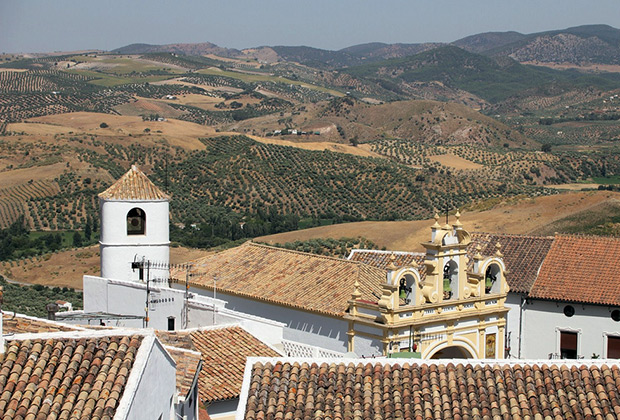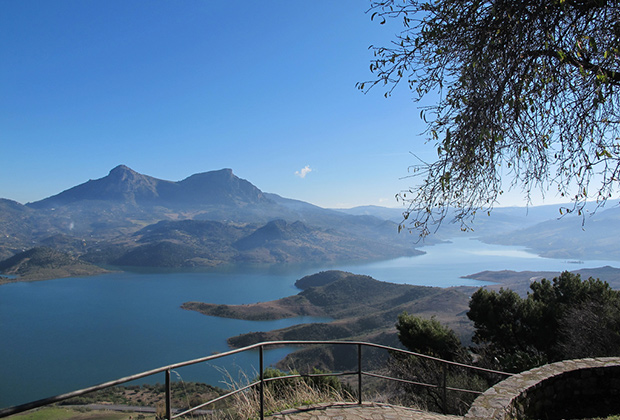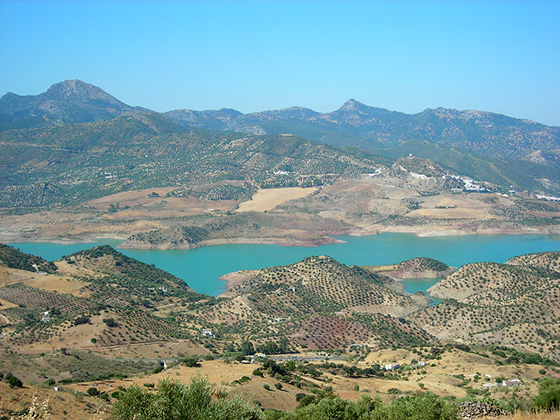














Patron Saint: San Simón and San Judas
Fiesta Dates:
Corpus Chisti (June)
Romería de Bocaleones (2nd fortnight of May)
Romería de San Juan (2nd fortnight of June)
Feria y fiestas de Agosto (3rd week of August)
Día de los Patronos (28th October)
Climate: The Sierra de Grazalema is the wettest area of Spain with over 88 inches of rain a year (but please note that almost all of it falls in the winter months, it’s as dry and sunny as the rest of Andalucía in summer)
At the northern end of the Grazalema Natural Park, this picturesque pueblo blanco overlooks the fabulous, azure-blue waters of the vast Embalse below.

Forty minutes north-west of Ronda, Zahara de la Sierra is one of the most spectacularly situated villages in Andalucía.
At the foot of the Sierra del Jaralin at the northern end of the Grazalema Natural Park, this picturesque pueblo blanco overlooks the fabulous, azure-blue waters of the vast Embalse below. High above the village, perched on its rocky outcrop, the remains of its Moorish castle stand guard over the whole valley. Scattered below on the slopes are the whitewashed houses of the village.
The town was originally an important Moorish outpost, overlooking and guarding the vast green valley below. The defensive system of the Nazari border consisted of an extensive network of towers and watchtowers that were visually linked along the entire border of the Muslim Kingdom.
Between Ronda and Sevilla, Zahara was of vital strategic importance, the perfect site for a fortress. The castle was built in the 8th Century and rebuilt once more in the 14th Century.
.
The town played a vital role as an important Moorish outpost, overlooking and guarding the vast green valley below.

It played a vital role in the conquests and reconquests which took place between 1407 and 1483 when it was finally taken by the Christian forces.
Throughout those years the inhabitants lived in constant danger and on permanent alert as Muslims and Christians fought over ownership. No women or children inhabited the village, just men ready for war.
The coat of arms of Zahara de la Sierra dates back to 1483, when Rodrigo Ponce de León conquered the village and received the title ”Marquis of Zahara” with the coat of arms that is now the town’s. It can be seen on the main balcony of the Town Hall on a red silk flag and also inside the Town Hall.
Today Zahara de la Sierra is more peaceful! Tourism plays the major role in sustaining the village and its people. Little bars, restaurants and hotels are visited by tourists taking the ruta de los pueblos blancos, visiting the heritage white villages of Andalucía. Zahara is a “must see” on this route.
Its little bars, restaurants and hotels are visited by tourists taking the ruta de los pueblos blancos. Here you will get a real taste of Spain.

This is especially true at the famous fiesta of Corpus Christi, which has been declared of National Tourist Interest. The people of Zahara dress up their houses with branches and rushes, making the whole place look as if it were part of nature. It is well worth visiting during this festival.
The huge reservoir, which is a relatively new edition, has made the village even more popular with visitors. As well as being a gorgeous sight, it also offers water sports and swimming.
Other sights worth seeing in Zahara include the Watch Tower, the Tore del Homenaje, the Church of Santa María de la Meza with its baroque altar piece and the Arch of the Town. Zahara de la Sierra was declared Patrimony of Humanity by UNESCO in 1977 and an Artistic Centre in 1983.
Here you will get a real taste of Spain. Accommodation and restaurants are generally more modest than, say, on the coast, and there is less evidence of British influence.
Having said that, the hotel / restaurant “Al Largo” which overlooks the reservoir constantly gets rave reviews, both for its delicious food and for its comfortable accommodation. It is the kind of small inn (there are just four guest rooms) where the owners’ personal touch is evident throughout. And they are an American and British couple!
If you walk up to the Moorish castle above the village and stand on its tower roof you will enjoy an amazing panorama over the sierras.

If you care to walk up to the Moorish castle and stand on its tower roof you will enjoy an amazing vista, with Algodonales and the Sierra de Lijar to the north, the Peñón Algarín above El Gastor to the east, the vast forested sierras in the direction of Grazalema to the south, and the Arroyo de Bocaleones and Sierra Margarita out towards Prado del Rey and El Bosque in the west.
You can visit the Garganta Verde (the Green Gorge) and Llano de Ravel. The Garganta Verde, a huge canyon off the road to Grazalema is very scenic and home to many griffon vultures. Access is prohibited during the nesting season.
Not far from the village, the Cueva del Susto (the Cave of Fright) contains an immense, underground lake whose waters supply the towns of both Zahara and El Gastor. Aptly named with its many scary precipices, stalactites and all this underground water, it is probably just as well that its entrance is currently covered with landslides.
Don't miss the wonderful drive over the mountains to Grazalema. Climbing ever higher, the blue lake slowly disappears from view far below as you ascend into the rugged, pine forested massifs all around.
Whilst in the area make sure you pay a visit to Molino El Vinculo, a traditional working olive mill just outside the village that offers guided tours and also a shop where you can buy high quality, cold pressed olive oil and other products such as local wines and preserves.
There is internet connection at the tourist office which also has information about the local area and wildlife, as well as a small shop selling local produce. The village has a fruit shop, butchers, bakers and fishmongers as well as a few small supermarkets.
There is a municipal swimming pool with a bar and restaurant, a large grass area for sunbathing and natural shade, dressing rooms and lifeguards. It is open to the public during July and August.
Zahara is the last village perched on the magnificent limestone mountains of the Sierra de Grazalema. Don’t miss the fabulous 16 km. drive over the mountains to the village of Grazalema. It’s a wonderful road, climbing ever higher, the blue lake slowly disappearing from view far below as you ascend into the rugged, pine forested massifs all around.
Well worth a visit, this “Moorish eagle’s nest” in the mountains.
















